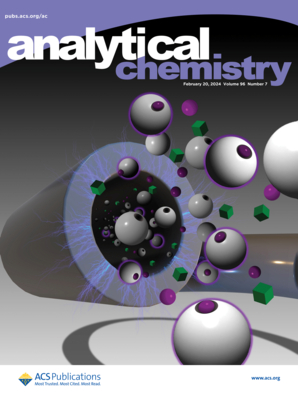A Novel Ratiometric Fluorescent Probe Based on Ortho-Position Oxime Functionalized Perylene Diimide for Supersensitive HClO/ClO- Recognition and Bioimaging in Cells and Zebrafish.
IF 6.7
1区 化学
Q1 CHEMISTRY, ANALYTICAL
引用次数: 0
Abstract
Hypochlorous acid (HClO) or hypochlorite (ClO-) not only is a common weak acid in daily life but also serves as a disinfectant and a key component of bleaching powder. Simultaneously, HClO/ClO- can also participate in many pathological processes as a kind of reactive oxygen species. To address the limitations in HClO/ClO- detection, we developed PDI-O, an ultrasensitive, rapid-response, and highly selective fluorescent probe, through rational molecular engineering of a perylene diimide scaffold and oxime as the recognition site. We systematically evaluated the photophysical properties and HClO/ClO- response performance of PDI-O through comprehensive spectral characterization. The probe demonstrates remarkable analytical metrics: (1) dual detection modes by UV-vis and fluorescence; (2) ultrahigh sensitivity with a subnanomolar detection limit (5 pM); (3) exceptional selectivity and anti-interference ability against 16 common interferences, including ions and reactive oxygen/nitrogen analogs; (4) rapid response speed (7.5 s); (5) wide linear range (0-8.0 μΜ); and (6) convenient visual detection toward smartphone-based RGB analysis. Notably, PDI-O exhibits dual-function bioimaging capabilities: it enables real-time discrimination of live/dead mammalian cells while achieving zebrafish larval imaging of HClO/ClO-. This novel ratiometric fluorescent probe establishes a new paradigm for developing precision biosensors to unravel hypochlorite-related pathophysiological cascades.基于邻位肟功能化苝酰二亚胺的新型比例荧光探针用于细胞和斑马鱼的超灵敏HClO/ClO-识别和生物成像。
次氯酸(HClO)或次氯酸盐(ClO-)是日常生活中常见的弱酸,也是消毒剂和漂白粉的关键成分。同时,HClO/ClO-也可以作为一种活性氧参与许多病理过程。为了解决HClO/ClO-检测的局限性,我们通过对苝二酰亚胺支架和肟作为识别位点进行合理的分子工程,开发了一种超灵敏、快速响应、高选择性的PDI-O荧光探针。我们通过全面的光谱表征系统地评价了PDI-O的光物理性质和HClO/ClO-响应性能。该探针具有显著的分析指标:(1)紫外-可见和荧光双重检测模式;(2)超高灵敏度,检测限为亚纳摩尔(5pm);(3)对16种常见干扰(包括离子和活性氧/氮类似物)具有卓越的选择性和抗干扰能力;(4)响应速度快(7.5 s);(5)线性范围宽(0-8.0 μΜ);(6)面向智能手机RGB分析的便捷视觉检测。值得注意的是,PDI-O具有双重功能的生物成像能力:它可以实时区分活/死哺乳动物细胞,同时实现斑马鱼幼虫对HClO/ClO-的成像。这种新型比例荧光探针为开发精密生物传感器以揭示次氯酸盐相关的病理生理级联建立了新的范例。
本文章由计算机程序翻译,如有差异,请以英文原文为准。
求助全文
约1分钟内获得全文
求助全文
来源期刊

Analytical Chemistry
化学-分析化学
CiteScore
12.10
自引率
12.20%
发文量
1949
审稿时长
1.4 months
期刊介绍:
Analytical Chemistry, a peer-reviewed research journal, focuses on disseminating new and original knowledge across all branches of analytical chemistry. Fundamental articles may explore general principles of chemical measurement science and need not directly address existing or potential analytical methodology. They can be entirely theoretical or report experimental results. Contributions may cover various phases of analytical operations, including sampling, bioanalysis, electrochemistry, mass spectrometry, microscale and nanoscale systems, environmental analysis, separations, spectroscopy, chemical reactions and selectivity, instrumentation, imaging, surface analysis, and data processing. Papers discussing known analytical methods should present a significant, original application of the method, a notable improvement, or results on an important analyte.
 求助内容:
求助内容: 应助结果提醒方式:
应助结果提醒方式:


